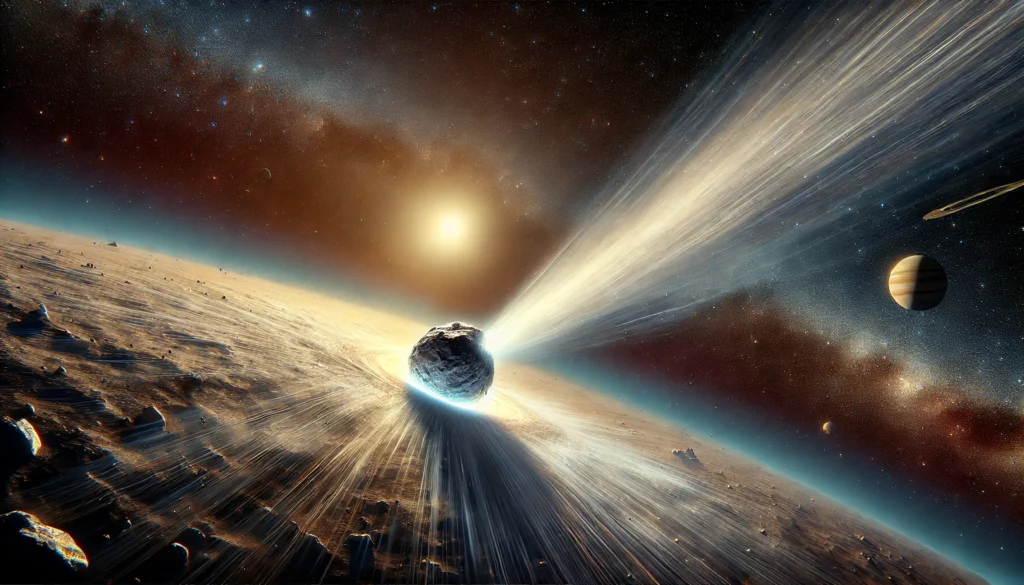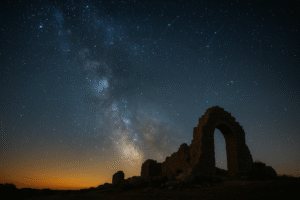Fun Fact: Did you know that the Kuiper Belt contains more than 100,000 icy bodies larger than 100 kilometres in diameter?
When we think of our solar system, the planets often take centre stage, with the Sun, Earth, Mars, and Jupiter grabbing all the attention. But beyond the orbit of Neptune lies a fascinating region known as the Kuiper Belt—our solar system’s frozen frontier. This vast expanse of icy bodies and dwarf planets holds the secrets to the early days of our solar system and has intrigued astronomers for decades. In this blog, we’ll embark on a journey to explore the Kuiper Belt, uncovering its mysteries and understanding its importance in the grand scheme of the cosmos.
What Is the Kuiper Belt?
The Kuiper Belt is a ring-shaped region in the outer solar system, starting just beyond Neptune’s orbit, approximately 30 astronomical units (AU) from the Sun, and stretching out to around 55 AU. To give context, one AU is the distance between Earth and the Sun, so the Kuiper Belt is located extremely far from our planet. It is similar to the asteroid belt, which lies between Mars and Jupiter, but it is much larger and contains far more icy bodies.
This frozen region is home to a variety of objects, including dwarf planets like Pluto and Eris, as well as smaller, icy bodies known as Kuiper Belt Objects (KBOs). Some of these objects are thought to be remnants from the early solar system, making them time capsules that offer clues about how our planetary neighbourhood formed and evolved.
The Discovery of the Kuiper Belt
Though the idea of a distant, icy region beyond Neptune had been proposed as early as the 1940s, it wasn’t until the early 1990s that the first KBOs were discovered. Astronomer Gerard Kuiper, for whom the belt is named, predicted the existence of such a region, but he didn’t live to see its discovery. In 1992, astronomers David Jewitt and Jane Luu spotted the first KBO, a small icy body about 280 kilometres in diameter. This discovery opened the door to more research, and since then, thousands of KBOs have been identified.
Perhaps the most famous object in the Kuiper Belt is Pluto, which was once considered the ninth planet in the solar system. In 2006, Pluto was reclassified as a dwarf planet by the International Astronomical Union (IAU) due to its size and its orbital path, which it shares with other icy objects in the Kuiper Belt.

Why Is the Kuiper Belt Important?
The Kuiper Belt holds a special place in the study of our solar system for several reasons:
Clues to Solar System Formation: KBOs are believed to be some of the oldest objects in the solar system, dating back to their formation 4.6 billion years ago. Studying these objects allows scientists to better understand the conditions and processes that influenced the formation of our solar system.
Dwarf Planets: The Kuiper Belt is home to several dwarf planets, including Pluto, Eris, Haumea, and Makemake. These distant worlds provide a window into planetary formation and the diversity of celestial bodies that exist in our solar system.
Comets: Many of the short-period comets that we observe from Earth—those that take less than 200 years to orbit the Sun—originate from the Kuiper Belt. These icy wanderers give us valuable information about the composition of the outer solar system.
Planet Nine?: Some astronomers believe that a yet-to-be-discovered ninth planet, dubbed “Planet Nine,” may be lurking in the outer reaches of the Kuiper Belt. This hypothetical planet could explain the unusual orbits of certain KBOs, which seem to be influenced by the gravity of a massive, unseen object.
The New Horizons Mission: A Journey to the Kuiper Belt
One of the most exciting milestones in the exploration of the Kuiper Belt came in 2015, when NASA’s New Horizons spacecraft flew by Pluto, giving us the most detailed images of the dwarf planet ever captured. New Horizons continued its exploration of the Kuiper Belt, and in 2019, it reached another distant object named Arrokoth. This ancient KBO, shaped like a snowman, is thought to be one of the most primitive objects ever studied.
The data from New Horizons has provided invaluable information about the Kuiper Belt, including details about the composition, temperature, and surface features of KBOs. This mission is a shining example of how space exploration is helping us learn more about the farthest reaches of our solar system.
The Mysteries of the Kuiper Belt
Despite the discoveries made so far, the Kuiper Belt remains full of mysteries. For example, scientists are still trying to understand how KBOs are formed. Unlike planets, which grow by accumulating material, KBOs seem to have formed through a process known as hierarchical accretion, where small particles stick together to form larger objects gradually. However, the low density and odd shapes of many KBOs suggest that this process may have worked differently in the outer solar system.
Another puzzle is the origin of the Kuiper Belt itself. Why did so many icy objects end up in this distant region? Some theories suggest that the giant planets—especially Neptune—played a role in pushing material outward during the early days of the solar system. Understanding this migration could help us piece together the full history of how our planetary system came to be.
Why Should We Care About the Kuiper Belt?
You might be wondering why the Kuiper Belt, located billions of kilometres away, should matter to us here on Earth. The answer lies in its potential to teach us about the broader universe. The Kuiper Belt isn’t unique to our solar system; similar regions likely exist around other stars as well. Studying these icy bodies can help astronomers understand how common planets and other celestial bodies are in the galaxy.
Furthermore, the Kuiper Belt holds the key to understanding the dynamics of planetary systems. By examining how objects interact and move within this frozen frontier, scientists can make predictions about the behaviour of other planetary systems, both near and far.
Conclusion
The Kuiper Belt may be far from Earth, but its significance is profound. It offers a glimpse into the early solar system, serves as a source of comets, and may even hold clues to the existence of another planet. As we continue to explore this frozen frontier with missions like New Horizons and future space telescopes, we are sure to uncover even more about this fascinating region of space.
So, the next time you gaze up at the night sky, remember that beyond the twinkling stars and glowing planets lies the Kuiper Belt—a vast, icy region filled with cosmic wonders just waiting to be explored.
Author’s Note
Exploring the Kuiper Belt has always sparked my curiosity, and I hope this blog has ignited some wonder in you as well. The farthest reaches of our solar system are still full of mysteries, and I can’t wait to see what future discoveries await us!
G.C., Ecosociosphere contributor.




